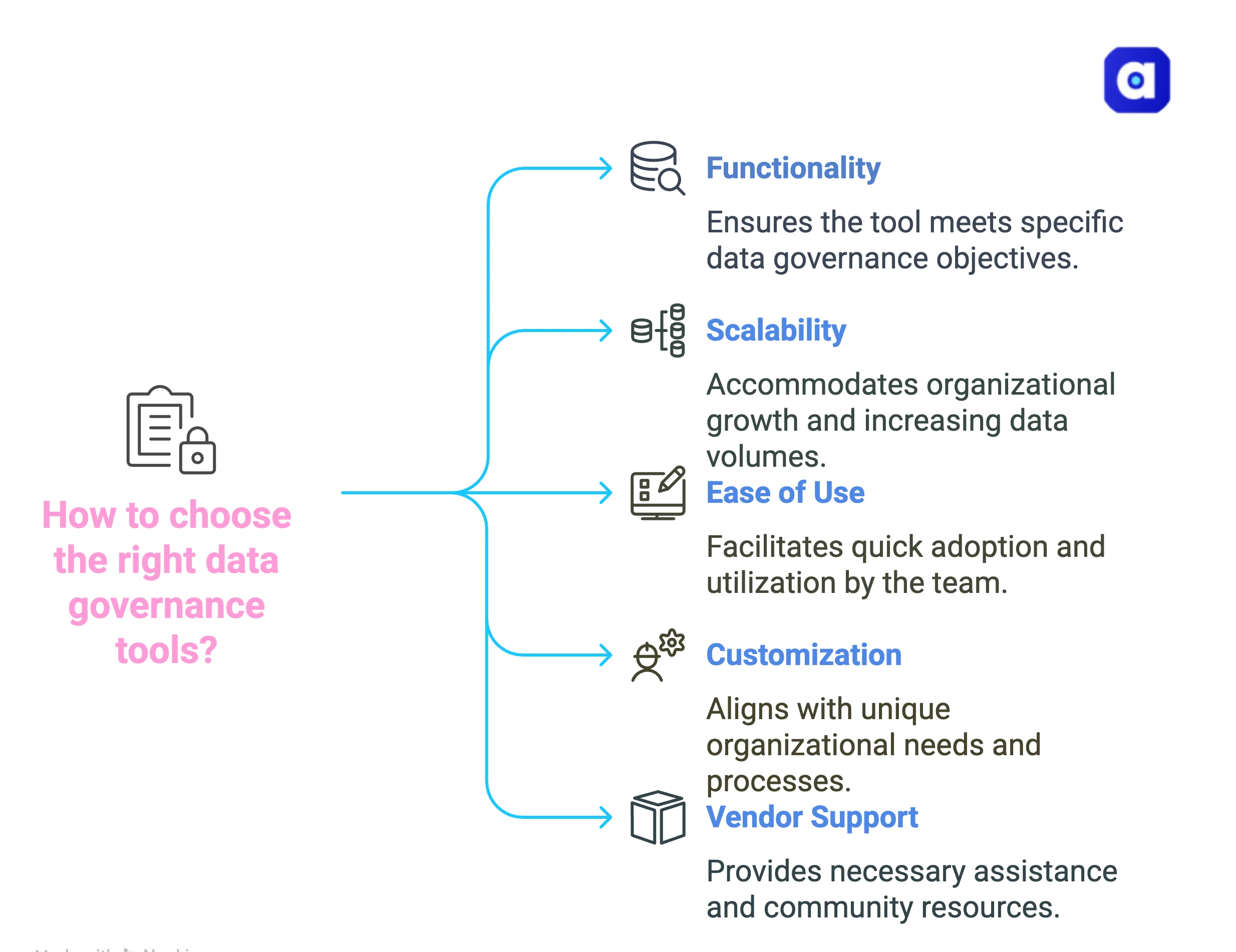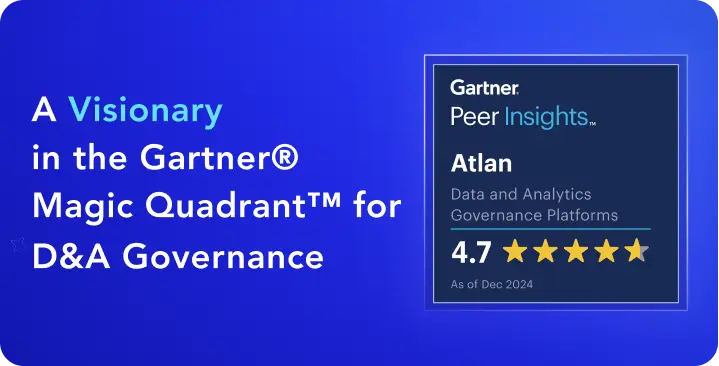Why is data governance non-negotiable in 2025? #
Summarize and analyze this article with 👉 🔮 Google AI Mode or 💬 ChatGPT or 🔍 Perplexity or 🤖 Claude or 🐦 Grok (X) .
Data now drives every strategic move, making governance the backbone of a modern business. As AI, machine learning, and real-time analytics surge, so do privacy mandates (GDPR, CCPA) and breach risks. Effective data governance turns raw information into a reliable, secure, and compliant asset are essential for sound decisions and sustained competitive edge, not a nice-to-have.
Your 10-step blueprint to implementing data governance #
Implementing a data governance plan in your organization can be crucial in achieving growth and industry leadership. So, let’s take a look at a step-by-step guide on how to implement data governance:
- Define goals and objectives
- Obtain executive support
- Establish a Data Governance Council
- Define data governance roles and responsibilities
- Develop a data governance framework
- Implement data governance tools
- Develop a data governance training program
- Monitor and measure data governance effectiveness
- Foster a data-driven culture
- Continuously improve your data governance program
1. Define goals and objectives #
Clearly outline the goals and objectives of your data governance plan. Make sure to focus on how it can position your organization as a leader in shaping data models and leveraging data for monetization within the industry.
2. Obtain executive support #
Gain buy-in from senior leadership to ensure the success of your data governance initiative. Also, present a well-prepared business case outlining the benefits and ROI of implementing data governance.
3. Establish a Data Governance Council #
You’ll need to form a cross-functional team with representatives from various departments, including IT, legal, finance, and operations. This team will be responsible for establishing policies, standards, and processes related to data management.
4. Define data governance roles and responsibilities #
Then, clearly outline the roles and responsibilities of data stewards, data owners, and data custodians within your organization. Ensure that each team member understands their role and is accountable for data management activities.
5. Develop a data governance framework #
Once you’re done outlining the roles and responsibilities, you need to develop a data governance framework. It should include policies, procedures, standards, and guidelines for data management. This framework should also account for data quality, data privacy and security, data lineage, metadata management, and data sharing.
6. Implement data governance tools #
The next step in your data governance plan is to invest in data governance tools and technologies that will automate and streamline data management processes. These tools can include data cataloging, data lineage tracking, data quality monitoring, and data privacy enforcement solutions.
7. Develop a data governance training program #
Provide ongoing training and education to your team members on data governance best practices, tools, and technologies. This will ensure that they understand the importance of data governance and are equipped to execute their roles effectively.
8. Monitor and measure data governance effectiveness #
In this step, you need to track the effectiveness of your data governance program by establishing key performance indicators (KPIs). You should regularly review these metrics and adjust your approach as needed.
9. Foster a data-driven culture #
It’s time to encourage a data-driven culture across your organization by promoting the value of data, sharing data insights, and rewarding employees who contribute to data governance initiatives.
10. Continuously improve your data governance program #
As your organization grows and evolves, so should your data governance program. That’s why you need to continuously evaluate and refine your processes, policies, and technologies to keep pace with industry best practices and the changing needs of your business.
By following these steps, you can implement a robust data governance program that will help your organization monetize data while ensuring compliance and maintaining the highest standards of data quality.
How to choose the right data governance tools for your enterprise? #
Selecting the appropriate data governance tools is critical for the success of your plan. Here are five essential factors to consider:
- Functionality: Does the tool provide comprehensive features like data cataloging, data lineage tracking, data quality management, and data privacy enforcement to meet your objectives?
- Scalability: Can the tool effectively accommodate your organization’s growth, increasing data volumes, and evolving complexity?
- Ease of Use: Is the platform intuitive and user-friendly, allowing your team to quickly adopt and utilize its capabilities?
- Customization and Flexibility: Can you tailor the tool to align with your organization’s unique data governance needs and specific processes?
- Vendor Support and Community: Evaluate the level of vendor support, including implementation assistance, documentation, training, and technical support. A vibrant user community can also be a valuable resource for knowledge sharing and best practices.

How to choose the right data governance tools in 2025. Source: Atlan.
What are the key roles in data governance, and how does a RACI chart help? #
Clearly defining roles and responsibilities is a cornerstone of effective data governance. Key roles typically include:
- Data Stewards: Responsible for data quality, definitions, and usage within specific domains.
- Data Owners: Accountable for the accuracy, privacy, and security of specific data assets.
- Data Custodians: Manage the technical aspects of data, including storage, maintenance, and security.
A RACI (Responsible, Accountable, Consulted, Informed) chart is a powerful tool to clarify these roles and responsibilities within data management activities. It visually maps who is:
- Responsible: The individual(s) who perform the task.
- Accountable: The individual ultimately answerable for the correct and thorough completion of the deliverable or task, and who delegates the work to the Responsible party.
- Consulted: The individual(s) whose opinions are sought, typically subject matter experts.
- Informed: The individual(s) who are kept up-to-date on progress or decisions.
Using a RACI chart ensures that each team member understands their role and is accountable for data management activities. This prevents confusion, promotes efficiency, and strengthens accountability across the data ecosystem.
What are the common challenges and tips for successful data governance implementation? #
Implementing data governance can come with challenges, but understanding and preparing for them can pave the way for success. Common pitfalls include resistance to change, lack of executive support, unclear roles and responsibilities, and difficulties integrating governance tools with existing systems.
To overcome these challenges and ensure a successful implementation, here are some key tips, particularly when building your business case:
- Secure Executive Buy-in: Present a well-prepared business case outlining the benefits and ROI of data governance. This directly counters the pitfall of insufficient executive support.
- Start with a Clear Problem Statement: Clearly articulate the data-related challenges your organization faces, such as data quality issues or compliance concerns. This helps to justify the initiative.
- Quantify Benefits: Whenever possible, quantify the potential benefits in terms of cost savings, revenue generation, or risk mitigation. Concrete examples help build a stronger case.
- Outline Risks of Inaction: Emphasize the potential consequences of not implementing data governance, such as regulatory fines or reputational damage.
- Present a Phased Approach: Propose a phased implementation plan that allows for quick wins and builds momentum. This can help management feel more confident and reduce perceived risk.
- Address Potential Objections: Anticipate and prepare to address concerns from management with well-researched facts and arguments.
- Foster a Data-Driven Culture: Encourage promoting the value of data and rewarding contributions to data governance. This helps mitigate resistance to change
Why is implementing data governance important in the AI era? #
McKinsey’s 2024 research confirms that 70% of top-performing companies face challenges integrating data into AI models, making robust governance frameworks essential for AI initiative success. AI fundamentally changes governance requirements, demanding new approaches to traditional challenges while introducing novel risk categories that require proactive management.
Bias detection – fairness dashboards #
AI governance traces lineage down to raw features and runs automated bias checks on every prediction. Dashboards flag demographic skew the moment source data drifts and can auto-trigger a retraining workflow, adding fairness metrics and parity checks to the traditional data-quality rule set.
Drift alerts – performance guardrails #
Live input data is continually compared with the model’s training baseline. When the distribution shifts, the system creates an incident ticket and pings model owners, ensuring that feature stores, model artefacts and deployment configs stay within performance bounds.
Audit snapshots – explainability compliance #
Every model deploy stores a “model card” that captures the exact training dataset, feature list and hyper-parameters. These snapshots give regulators and stakeholders a full lineage trail—from raw data to final prediction—meeting emerging AI audit and explainability rules.
Input validation – continuous QA #
Governance pipelines run schema, freshness and outlier checks on every incoming batch before inference. Catching bad data upstream prevents silent corruption of production models and shifts quality assurance left in the ML lifecycle.
Real wins from real customers: What does successful data governance implementation look like? #

Modernized data stack and launched new products faster while safeguarding sensitive data
“Austin Capital Bank has embraced Atlan as their Active Metadata Management solution to modernize their data stack and enhance data governance. Ian Bass, Head of Data & Analytics, highlighted, ‘We needed a tool for data governance… an interface built on top of Snowflake to easily see who has access to what.’ With Atlan, they launched new products with unprecedented speed while ensuring sensitive data is protected through advanced masking policies.”

Ian Bass, Head of Data & Analytics
Austin Capital Bank
🎧 Listen to podcast: Austin Capital Bank From Data Chaos to Data Confidence

53 % less engineering workload and 20 % higher data-user satisfaction
“Kiwi.com has transformed its data governance by consolidating thousands of data assets into 58 discoverable data products using Atlan. ‘Atlan reduced our central engineering workload by 53 % and improved data user satisfaction by 20 %,’ Kiwi.com shared. Atlan’s intuitive interface streamlines access to essential information like ownership, contracts, and data quality issues, driving efficient governance across teams.”
Data Team
Kiwi.com
🎧 Listen to podcast: How Kiwi.com Unified Its Stack with Atlan

One trusted home for every KPI and dashboard
“Contentsquare relies on Atlan to power its data governance and support Business Intelligence efforts. Otavio Leite Bastos, Global Data Governance Lead, explained, ‘Atlan is the home for every KPI and dashboard, making data simple and trustworthy.’ With Atlan’s integration with Monte Carlo, Contentsquare has improved data quality communication across stakeholders, ensuring effective governance across their entire data estate.”

Otavio Leite Bastos, Global Data Governance Lead
Contentsquare
🎧 Listen to podcast: Contentsquare’s Data Renaissance with Atlan
Bringing it all together #
By focusing on the points above, you can create a strong foundation for your data governance program, producing tangible improvements in data quality, compliance, and overall decision-making in your organization.
Implementing a solid data governance plan requires a toolset that improves security and compliance without compromising data democratization.
Implement your data governance with expert help -
Book a Personalized Demo →FAQs about how to implement data governance #
1. How can you implement data governance? #
Implementing data governance involves defining clear goals, obtaining executive support, establishing a governance council, and developing a framework. It also includes selecting appropriate tools and fostering a data-driven culture within the organization.
2. What are the key components of a successful data governance strategy? #
A successful data governance strategy includes defined roles and responsibilities, a comprehensive framework for data management, effective tools for monitoring data quality, and ongoing training for staff to ensure compliance and best practices.
3. How does data governance impact data quality and compliance? #
Data governance directly enhances data quality by establishing standards and processes for data management. It ensures compliance with regulations by implementing policies that protect data privacy and security, reducing the risk of breaches and penalties.
4. What are the common challenges faced when establishing data governance? #
Common challenges include resistance to change, lack of executive support, unclear roles and responsibilities, and difficulties in integrating governance tools with existing systems. Addressing these challenges requires strong leadership and a clear communication strategy.
5. How can data governance support data privacy regulations like GDPR or CCPA? #
Data governance supports privacy regulations by establishing policies for data handling, access control, and compliance monitoring. It ensures that organizations manage personal data responsibly, maintain transparency, and uphold individuals’ rights regarding their data.














